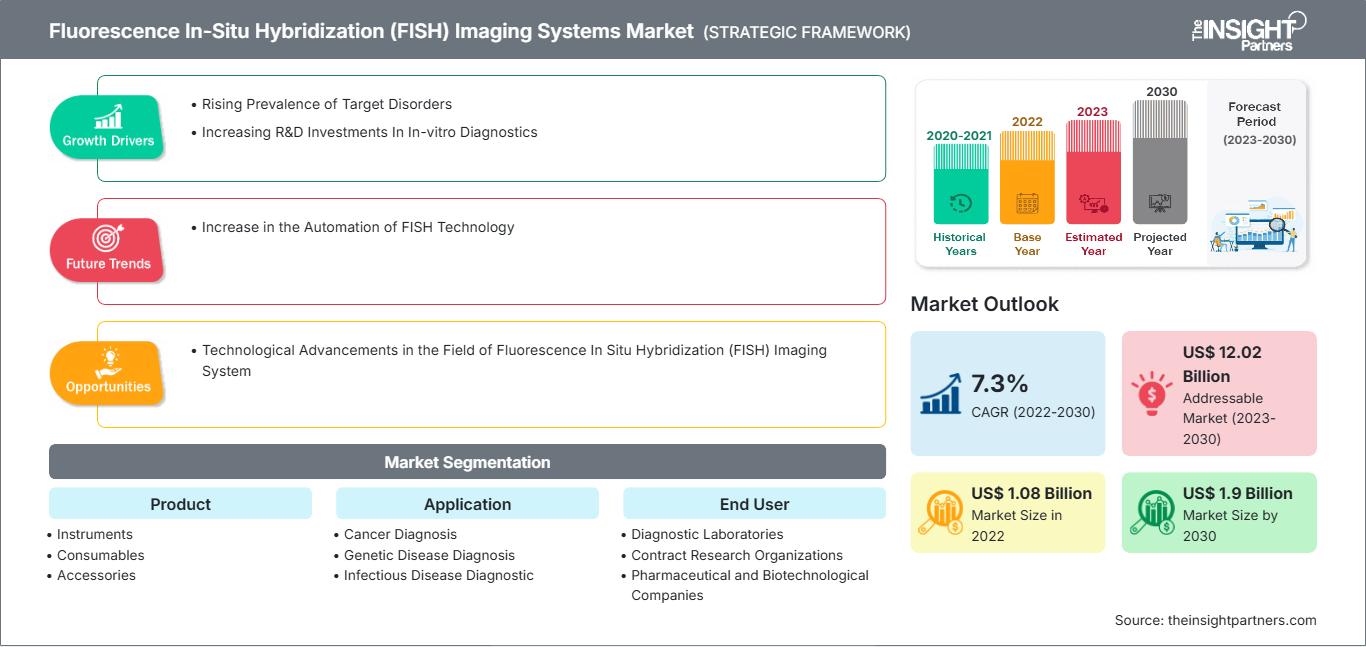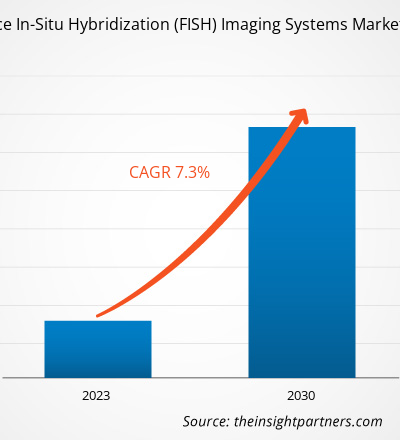[調査レポート] 蛍光 in situ ハイブリダイゼーション (FISH) イメージング システム市場は、2022 年の 10 億 8,400 万米ドルから成長し、2030 年までに 19 億 140 万米ドルに達すると見込まれ、2022 年から 2030 年にかけて 7.3% の CAGR を記録することが予想されています。
市場分析とアナリストの見解:
蛍光 in situ ハイブリダイゼーション (FISH) は、細胞遺伝学的分析のための分子技術です。この技術では、高度な配列相補性を持つ核酸配列の特定の部分にのみ結合する蛍光プローブを使用します。FISH は、染色体上の特定の DNA 配列の有無を検出します。FISH は、医療、遺伝カウンセリング、種の識別のために DNA/RNA ターゲットの特定の特徴を見つけるためによく使用されます。蛍光in situハイブリダイゼーション(FISH)イメージングシステム市場の成長を牽引する主な要因としては、対象疾患の罹患率の上昇と体外診断への研究開発投資の増加が挙げられます。しかしながら、FISHイメージングシステムと手順の高コストが市場の成長を阻害しています。
成長促進要因と阻害要因:
FISHは、細胞または組織内の特定のDNA配列の可視化と局在化を可能にする強力な分子細胞遺伝学的手法です。この技術は遺伝学および診断学の分野に革命をもたらし、研究者や臨床医に遺伝子異常、染色体再編成、そして様々な疾患に関する貴重な知見を提供しています。遺伝性症候群、がん、その他の遺伝子異常といった対象疾患の罹患率の上昇は、FISHイメージングシステムの需要を促進しています。国立医学図書館によると、米国では2023年に1.96人の新たながん症例と609,820人のがんによる死亡が記録されると予想されています。これらの対象疾患の罹患率が継続的に上昇するにつれて、正確で信頼性の高い診断ツールの需要が急増しています。 FISHイメージングシステムは、微妙な遺伝子変化の検出に役立つ高解像度画像を提供し、病気の早期診断と個別化された治療アプローチを可能にします。これらの疾患には遺伝子変異や変異が伴うことが多く、FISHイメージングシステムを使用して正確に識別および特徴付けることができます。細胞内の特定の遺伝子またはDNA配列の位置を正確にマッピングする能力は、疾患のメカニズムを理解し、標的療法を開発し、情報に基づいた臨床決定を行うために重要であることが証明されています。
FISHの顕著な利点は、ホルマリン固定パラフィン包埋組織、細胞学的標本、新鮮組織など、さまざまなサンプルタイプを処理できることです。この汎用性により、FISH は研究と臨床の両方の現場で不可欠なツールとなり、白血病、リンパ腫、固形腫瘍、先天性疾患などの疾患に関連する遺伝子マーカーの特定が可能になりました。
要件に合わせてレポートをカスタマイズ
レポートの一部、国レベルの分析、Excelデータパックなどを含め、スタートアップ&大学向けに特別オファーや割引もご利用いただけます(無償)
蛍光in-situハイブリダイゼーション(FISH)イメージングシステム市場: 戦略的洞察

-
このレポートの主要な市場動向を入手してください。この無料サンプルには、市場動向から見積もりや予測に至るまでのデータ分析が含まれます。
蛍光in situハイブリダイゼーション(FISH)イメージングシステム市場は、体外診断(IVD)関連の研究開発(R&D)活動への継続的な投資によってさらに牽引されています。細胞環境内の特定のDNA配列を視覚化する独自の能力を持つFISH法は、現代の診断、特に遺伝性疾患や希少疾患の検出において重要な手法として浮上しています。IVDへの研究開発資金の急増は、FISHイメージングシステムの革新的な進歩を促進し、研究者が合理化された自動化をサポートする機能を備えた高画質の画像を提供する最先端プラットフォームを開発することを可能にし、より正確で迅速な診断プロセスを実現しています。 PNA FISHは、ペプチド核酸(PNA)プローブを用いたFISHを使用する新しい診断法であり、従来の染色法の簡便さとPNAプローブの優れた性能を組み合わせることで、伝染病の迅速かつ正確な診断を実現します。そのため、PNA FISHは日常的な応用に適しており、臨床微生物学研究室は、従来の生化学的方法を使用した場合では不可能な時間枠内で、患者治療に関する重要な情報を報告できます。
ただし、FISHイメージング分析は、他の方法よりも比較的コストが高いため、がん検出ではあまり使用されていません。機器コストに加えて、試薬、その他の消耗品、および専門の人員の雇用に関連する費用が、FISHイメージングに基づく評価の全体的なコストに加算される可能性があります。例えば、IHCによるALK遺伝子非小細胞肺がんの検出費用は、米国では1回あたり90.07米ドル、欧州では1回あたり68.69米ドルです。これは、FISHとIHCによる単独または並行検査(1回あたり米国で約441.85米ドル、欧州で約279.46米ドル)よりも安価です。このように、手順とシステムの高コストが、蛍光in situハイブリダイゼーション(FISH)イメージングシステム市場の成長を制限しています。
レポートのセグメンテーションと範囲:
「世界の蛍光in situハイブリダイゼーション(FISH)イメージングシステム市場」は、製品、アプリケーション、エンドユーザーに基づいてセグメント化されています。製品に基づいて、市場は機器、消耗品、アクセサリ、ソフトウェアに分類されています。アプリケーション別に見ると、蛍光 in situ ハイブリダイゼーション (FISH) イメージング システム市場は、がん診断、遺伝性疾患診断、感染症診断、その他に分類されています。エンドユーザー別に見ると、診断ラボ、契約研究機関、製薬およびバイオテクノロジー企業、その他に分類されています。地域別に見ると、蛍光 in situ ハイブリダイゼーション (FISH) イメージング システム市場は、北米 (米国、カナダ、メキシコ)、欧州 (ドイツ、フランス、イタリア、英国、ロシア、その他の欧州諸国)、アジア太平洋 (オーストラリア、中国、日本、インド、韓国、その他のアジア太平洋諸国)、中東およびアフリカ (南アフリカ、サウジアラビア、UAE、その他の中東およびアフリカ)、南アフリカおよび米国に分類されています。
セグメント分析:
蛍光 in situ ハイブリダイゼーション(FISH)イメージング システム市場は、製品別に、機器、消耗品、アクセサリ、ソフトウェアに分類されています。消耗品セグメントは 2022 年に最大の市場シェアを占め、2022 年から 2030 年にかけて最高の CAGR を記録すると予想されています。消耗品は、蛍光 in situ ハイブリダイゼーション(FISH)イメージング システム市場で最も有望なセグメントであり、今後数年間で大きな成長に貢献します。FISH 消耗品には、ハイブリダイゼーション バッファー、プローブ、タグ検出キット、シグナル増幅検出キットなどが含まれます。Abbott、F. Abnova、Thermo Fisher Scientific などのメーカーの存在が、消耗品セグメントの市場を強化しています。これらの製品は、さまざまな研究診断プロセスで頻繁に使用されており、消費を促進すると予想されます。したがって、プローブやキットを提供する様々な市場プレーヤーの存在と、それらプレーヤーによる技術革新は、今後数年間、このセグメントの市場を牽引する可能性が高いと考えられます。
用途別に見ると、蛍光in-situハイブリダイゼーション(FISH)イメージングシステム市場は、がん診断、遺伝性疾患診断、感染症診断、その他に分類されます。がん診断セグメントは2022年に最大の市場シェアを占め、2022年から2030年にかけて最も高いCAGRを記録すると予想されています。FISH技術はがん診断に多大な恩恵をもたらしてきました。FISHイメージングシステムは遺伝子変異を検出し、異常の検出に役立ちます。 Cancer Research UKによると、FISH検査は乳がん、リンパ腫、肺がん、前立腺がん、慢性リンパ性白血病(CLL)、急性リンパ芽球性白血病(ALL)、急性骨髄性白血病(AML)、慢性骨髄性白血病(CML)、骨髄腫、ユーイング肉腫、黒色腫皮膚がんなど、さまざまながんの診断に使用されています。
エンドユーザーに基づいて、蛍光in situハイブリダイゼーション(FISH)イメージングシステム市場は、診断ラボ、契約研究機関、製薬およびバイオテクノロジー企業、およびその他の分野に分類されています。診断ラボセグメントは2022年に最大の市場シェアを占め、2022年から2030年にかけて最高のCAGRを記録すると予想されています。診断ラボは、蛍光in situハイブリダイゼーション(FISH)イメージングプロセス用のさまざまな技術と製品を開発するためのさまざまな研究プロジェクトに関与しています。研究と技術における前例のない発展は、ヘルスケアとライフサイエンスの分野で変革の可能性を生み出しています。蛍光 in situ ハイブリダイゼーション(FISH)イメージングシステムの臨床応用は広範で、慢性疾患の診断と治療能力を高める機会を提供します。遺伝子の発見と希少遺伝性疾患の診断に大きな可能性を秘めています。この技術は、がん、高血圧、糖尿病、腎臓病など、一般的な疾患の発症に影響を及ぼす希少および一般的な遺伝因子の分析にますます使用されています。
地域分析:
地理に基づいて、世界の蛍光 in situ ハイブリダイゼーション(FISH)イメージングシステム市場は、北米、ヨーロッパ、アジア太平洋、南米および中米、中東およびアフリカの5つの主要地域に分割されています。2022年には、北米が世界の蛍光 in situ ハイブリダイゼーション(FISH)イメージングシステム市場規模で最大のシェアを占めました。アジア太平洋地域は、2022年から2030年にかけて最高のCAGRを記録すると予測されています。
予測期間中、米国は蛍光in situハイブリダイゼーション(FISH)イメージングシステム市場で最大のシェアを占めると予測されています。米国は、北米の蛍光in situハイブリダイゼーション(FISH)イメージングシステム市場で大きなシェアを占めています。分子遺伝学と細胞遺伝学の高度な診断ツールの需要の高まりと、遺伝性疾患と癌の罹患率の上昇により、米国では蛍光in situハイブリダイゼーション(FISH)イメージングシステムの採用が促進されています。米国癌協会が2022年に発表したデータによると、米国では約190万件の癌症例が診断され、609,360人の癌による死亡が報告されました。これらのシステムは遺伝物質の高解像度画像を提供し、研究者や臨床医が染色体異常や遺伝子変異をより正確に検出することを可能にします。さらに、個別化医療や標的治療への関心の高まりにより、遺伝子解析を伴う研究活動が急増し、FISHイメージングシステムの需要が高まっています。細胞内の遺伝子配列に関する詳細な空間情報を直接提供できるこれらのシステムの能力は、研究と臨床応用の両面で非常に貴重であることが証明されています。FISHイメージングシステムは、自動化の向上、スループットの向上、画像解析ソフトウェアの強化といった技術的進歩により、近年非常に高い人気を誇っています。その結果、研究室や医療機関は、より大量のサンプルを扱い、効率的に正確な結果を得るための設備をより適切に整えることができます。したがって、分子遺伝学と細胞遺伝学の高度な診断ツールに対する需要の高まりと、遺伝性疾患と癌の罹患率の上昇は、米国の蛍光 in situ ハイブリダイゼーション (FISH) イメージング システム市場を強化します。
業界の発展と将来の機会:
世界の蛍光 in situ ハイブリダイゼーション (FISH) イメージング システム市場で活動している主要企業が行っているさまざまな取り組みを以下に示します。
- 2023 年 5 月、ファイザーとサーモフィッシャーサイエンティフィックは協力して、高度なゲノム検査がこれまで制限されていた、または利用できなかったラテンアメリカ、アフリカ、中東、アジアの 30 か国以上で、肺がんおよび乳がんの患者に対する次世代シーケンシング (NGS) ベースの検査への現地でのアクセスの向上を支援しました。ローカルNGS検査へのアクセスにより、関連遺伝子のより迅速な分析が可能になり、医療提供者は特定の患者に最適な薬を選択できるようになります。
- 2023年4月、Agilent Technologies Incは韓国のTheragen Bioと覚書を締結しました。パートナーシップ契約の一環として、アジレントと Theragen Bio は、がんゲノムプロファイリング設計、エンジニアリングの知識、ソフトウェアの専門知識におけるそれぞれの強みを組み合わせ、局所的な分析機能を強化し、治療の決定を迅速化しました。
- 2023 年 4 月、MetaSystems Probes GmbH は 4 つの新しい XCyting New MetaSystems プローブ(XL t(11;14) CCND1/IGH DF、XL CCND3/IGH DF、XL CUX1/EZH2/7cen、XL DiGeorge TBX1)をリリースしました。
- 2022 年 5 月、MetaSystems Probes GmbH は 3 つの新しい XCyting 遺伝子座特異的ブレークアパート プローブ(XL TCL1 BA、XL SPI1 BA、XL CSF1R BA)を血液学および腫瘍学のポートフォリオに追加しました。 XL TCL1 BAは、複数のT細胞前リンパ球性白血病(T-PLL)症例で報告されている転座を伴うTCL1遺伝子クラスター座位を検出するように設計されています。XL SPI1 BAは、小児T細胞急性リンパ性白血病(T-ALL)症例で報告されている転座を伴うSPI1遺伝子座位の検出に適しています。XL CSF1R BAは、B細胞前駆細胞性ALLを含む、ALL疾患の高リスクサブセットで報告されている複数の転座に関与する主要な遺伝子の1つです。
- 2021年12月、BioGenex Laboratories Incは、がん診断用の3つの新しい一次免疫組織化学(IHC)抗体(CD8A、CD56、CD163)を発売しました。
蛍光in-situハイブリダイゼーション(FISH)イメージングシステム市場の地域別分析
The Insight Partnersのアナリストは、予測期間全体を通して蛍光in-situハイブリダイゼーション(FISH)イメージングシステム市場に影響を与える地域的な動向と要因を詳細に解説しています。このセクションでは、北米、ヨーロッパ、アジア太平洋、中東・アフリカ、中南米における蛍光in-situハイブリダイゼーション(FISH)イメージングシステム市場のセグメントと地域についても解説しています。
蛍光in-situハイブリダイゼーション(FISH)イメージングシステム市場レポートの範囲
| レポート属性 | 詳細 |
|---|---|
| の市場規模 2022 | US$ 1.08 Billion |
| 市場規模別 2030 | US$ 1.9 Billion |
| 世界的なCAGR (2022 - 2030) | 7.3% |
| 過去データ | 2020-2021 |
| 予測期間 | 2023-2030 |
| 対象セグメント |
By 製品
|
| 対象地域と国 |
北米
|
| 市場リーダーと主要企業の概要 |
|
蛍光in-situハイブリダイゼーション(FISH)イメージングシステム市場のプレーヤー密度:ビジネスダイナミクスへの影響を理解する
蛍光in-situハイブリダイゼーション(FISH)イメージングシステム市場は、消費者の嗜好の変化、技術の進歩、製品メリットへの認知度の向上といった要因によるエンドユーザー需要の高まりに牽引され、急速に成長しています。需要の高まりに伴い、企業は製品ラインナップの拡充、消費者ニーズへの対応、新たなトレンドの活用を進めており、これが市場成長のさらなる加速につながっています。

- 入手 蛍光in-situハイブリダイゼーション(FISH)イメージングシステム市場 主要プレーヤーの概要
競合状況と主要企業:
Euroclone SpA、TissueGnostics GmbH、Agilent Technologies Inc、Abnova Taiwan Corp、BioGenex Laboratories Inc、Leica Biosystems Nussloch GmbH、MetaSystems Probes GmbH、Bio-View Ltd、Thermo Fisher Scientific Inc、Applied Spectral Imaging、PerkinElmer Inc は、蛍光 in situ ハイブリダイゼーション(FISH)イメージングシステム市場で事業を展開する主要企業です。これらの企業は、世界中で高まる消費者需要に対応し、専門ポートフォリオにおける製品ラインナップを拡大するため、新技術、既存製品の改良、そして地理的拡大に注力しています。
- 過去2年間の分析、基準年、CAGRによる予測(7年間)
- PEST分析とSWOT分析
- 市場規模価値/数量 - 世界、地域、国
- 業界と競争環境
- Excel データセット
最新レポート
お客様の声
購入理由
- 情報に基づいた意思決定
- 市場動向の理解
- 競合分析
- 顧客インサイト
- 市場予測
- リスク軽減
- 戦略計画
- 投資の正当性
- 新興市場の特定
- マーケティング戦略の強化
- 業務効率の向上
- 規制動向への対応






















 無料サンプルを入手 - 蛍光in-situハイブリダイゼーション(FISH)イメージングシステム市場
無料サンプルを入手 - 蛍光in-situハイブリダイゼーション(FISH)イメージングシステム市場